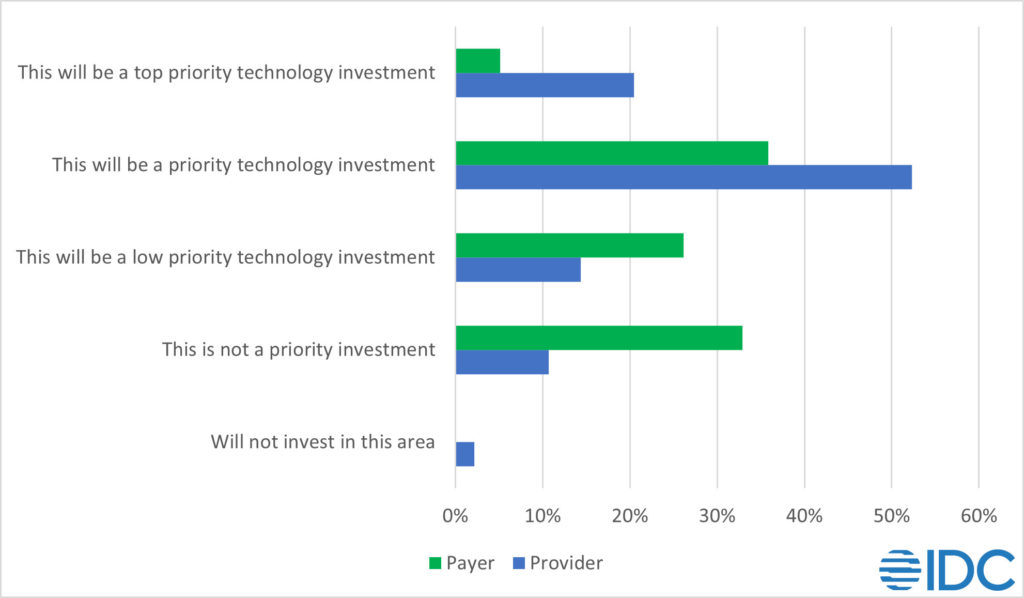For guidance on how healthcare organizations can leverage connected health technologies to support care anywhere initiatives and create a better experience for healthcare providers and patients, join us for the webinar, Driving Patient-Centric Care: Innovating Drug Development and Care Delivery with Connected Health Technologies, live on July 20 at 11 am EDT.
COVID-19 showed how resourceful healthcare and life science organizations could be in the midst of a global pandemic. As the science of how the coronavirus worked and how to contain it evolved, those on the front line had to respond quickly to make course corrections. In many ways, they were fixing the plane while flying it. This was no small feat with so many lives on the line including patients, direct care health providers, first responders, and staff.
Creating resiliency is a top objective for providers and payers. In the May 2021 wave of IDC’s Future Enterprise Resiliency & Spending Survey, 38.4% of providers and 36.9% of payers reported that following COVID-19 they expanded their resiliency plans for 2021-2022 to support the unique requirements of a pandemic. Furthermore, they are expanding their initiatives to include their responses to any future business disruption. To that end, investing in digital infrastructure is a priority technology investment for healthcare organizations. (See figure 1)
Figure 1: Investing in Digital Infrastructure is a Priority for Healthcare Organizations
Q. Which statement best describes your organization’s view on the priority of digital infrastructure resiliency investments over the next 2 years, as it relates to ensuring the long-term resilience and success of the business?

Source: Future Enterprise Resiliency & Spending Survey, May, 2021
Provider N = 69 | Payer N = 17
How Will Digital Infrastructure Resiliency Enable Reimagining Healthcare
The global pandemic has changed nearly every part of our daily lives – how we work, shop, educate our children, bank, socialize, and access care, to name a few examples. Many of these changes will persist after the pandemic abates because consumers appreciate the convenience of not commuting to work or shopping online for groceries and having them delivered to their homes. The same is true for healthcare services.
Shifting to Remote Care
Concerns over contracting COVID-19 inhibited consumers from seeking in-person care and in the early days of the pandemic many practices restricted how many patients were seen in person to only the very sick. According to the IDC Consumer Experiences Survey, 34% of consumers reported they visited a doctor or healthcare facility virtually since COVID-19 began and 41.6% of them would like to see virtual visits continue after the pandemic.
IDC Health Insights believes that while virtual visit volume will not be as high as it was during the height of the pandemic, virtual visits will continue for certain types of services such as managing chronic conditions and behavioral and mental health therapy. The eBook, Connected Health Technology: Enabling Care Anywhere, further details how the use of connected health technology such as remote health monitoring devices and mobile health apps makes it possible to manage post-acute care patients at home and offer hospital at home services safely and more effectively.
Removing Friction and Streamlining Patient Engagement
Navigating the U.S. healthcare system has never been easy, challenging all stakeholders – patients, healthcare providers, and payers. A more connected health care system, with more digital and virtual touch points upfront and throughout the service will alleviate much of the friction in healthcare processes. To that end, healthcare organizations are creating a digital front door that replicates all aspects of the patient engagement experience up to the point where patients physically walk through the door for their appointment. The virtual triage contact center, video visits, appointment management, digital intake process, and mobile support are all part of streamlining the patient engagement process through technology.
Improving Healthcare Operations
Healthcare organizations had to transform their facilities, workforce, and workplace to respond to COVID-19 requirements and protect patients and staff from exposure to the coronavirus. Some of these changes like no-visitors policies or separate waiting rooms for patients suspected of or confirmed as having COVID-19 will thankfully come to an end.
However, other changes such as the increased use of robots to deliver supplies to hospital units or disinfect treatment and patient rooms should continue post pandemic to streamline healthcare operations and reduce costs. Similarly, investment in real-time location services and tagged devices to track and locate critical devices such as ventilators and personal protective equipment which became increasingly important as hospitals faced dwindling supplies will pay off in the efficiencies they create when widely deployed to track other essential hospital equipment.
Parting Thoughts
Smart connected health technologies will play a critical role in shaping how and where healthcare is delivered now and into the next normal. Out of necessity healthcare organizations had to pivot overnight to develop alternative solutions for triaging, treating, and monitoring patients without patients being seen in traditional health settings. While the care anywhere movement had certainly begun prior to the emergence of the coronavirus, the global pandemic is accelerating the widespread adoption of virtual health services to provide care anywhere. For more guidance on how healthcare organizations can leverage connected health technologies to support care anywhere initiatives and create a better experience for healthcare providers and patients, please join us for the webinar Driving Patient-Centric Care: Innovating Drug Development and Care Delivery with Connected Health Technologies on July 20 at 11 am EDT. Click the button below to register.




